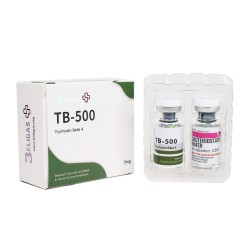
This warehouse cannot ship to Military addresses, Norway, Denmark, Israel, Alaska, Hawaii, Puerto Rico and Guam.
DO NOT order if you are based in these locations.
Respectfully,
OSGear Team
Thymosin Beta 4 (TB-500) 5mg - Beligas
CLASSIFICATION Multifaceted Peptide
ACNE No
WATER RETENTION No
HBR No
HEPATOTOXICITY No
AROMATIZATION No
MANUFACTURER Beligas
WAREHOUSE International Warehouse 3
SUBSTANCE
Thymosin Beta-4,
DO NOT FREEZE! DO NOT STORE AT ROOM TEMPERATURE!
TB-500 is a synthetic peptide version of the naturally occuring healing protein present in about all human and mammalian cells known as Thymosin Beta 4 (TB4). Research has shown TB 500 to have beneficial effects on wound healing, injury recovery, flexibility, and inflammation. These desirable effects are accomplished through TB 500’s influence on blood cell and blood vessel development, cellular differentiation, and cell migration. A major part of its healing capability stems from the peptide’s regulation of actin, a cell building protein essential to healing and wound repair.
TB-500 Dosage
TB500 comes as a freeze dried (lyophilized) powder. Research has shown that best results are achieved when bacteriostatic sodium chloride 0.9% is used to reconstitute thymosin peptides. TB 500 dosages can range from 5mg to 20 mg per week. Administration is generally divided into 2-3 injections per week. Once the peptide is built up in the system, the weekly dosage is generally lowered a bit to a maintenance dosage of about half or less of the original weekly dose. Administration of maintenance dosage can be made once per week.
TB500 is typically injected subcutaneously, though it can also be injected into muscle if desired.
How to Store TB 500: Store the product at room temperature in a non-humid environment. The vial should be shielded from light. An opened vial can be kept for up to 8 days refrigerated.
What is TB-500
TB 500 research illustrates multiple properties that have provided the impetus for a worldwide series of clinical trials of potential effectiveness for thymosin beta-4 in promoting repair of wounds in skin, cornea and heart. Thymosin beta 4 is produced in the thymus gland and is found in high concentrations in wound fluids. As such it has been observed to facilitate healing of injured tissue in the body.
TB-500 is a naturally occurring peptide found in high concentrations in blood platelets, wound fluid and other tissues. TB-500 peptides for research are not growth factors; rather major actin regulating protein peptides. TB 500 has been found to play an important role in protection, regeneration and remodeling of injured and/or damaged tissues. The gene for Thymosin Beta-4 has also been found to be one of the first to be stimulated after an incident of injury.
Present in almost all human and animal cells, Thymosin Beta 4 is naturally occurring wound healing peptide. TB 500 is a synthetically made version of TB4 that facilitates healing and recovery by helping build new blood vessels, muscle tissue fibers, blood cells, and facilitating cell migration. For the overworked or injured individual, TB 500 offers extremely enticing wound healing effects.
How Does TB 500 Work?
TB 500 is able to help recovery by exerting effects on actin. By up-regulating this cellular protein, TB 500 is able to capitalize on actin’s positive effects. These include the promotion of cell migration and proliferation. As a result, new blood vessels form and inflammation can be regulated so that healing and recovery are optimized. In addition, TB 500’s unique molecular structure allows it to travel long distances in the body. This enables it to exert a “systemic” effect, seeking out and helping those areas of the body suffering injury. Further beneficial results of TB 500 administration can include reduced inflammation and enhanced flexibility. There have even been some reports of regrowing and darkening of hair.
What TB 500 Side Effects Are There?
There are many positive effects associated with Tb500 use, including enhanced recovery, reduced inflammation, and improved flexibility. The peptide works very effectively to aid recovery of slow healing injuries such as those to connective tissue, i.e. tendons and ligaments. Muscle injuries and injuries to skin are greatly helped as well. From reports from users and researchers around the globe, TB 500 seems to cause very few, if any, serious negative side effects.
Most peptides generally can produce a lightheadedness or nauseous feeling upon injection. Also, flu-like symptoms are prevalent among many other peptides as well. However, the incidence of these negative side effects occurring with TB500 administration is reported to be very low, if at all. TB 500 appears to be a very well tolerated peptide among users.
The information presented on this web site is not intended to take the place of your personal physician’s advice and is not intended to diagnose, treat, cure or prevent any disease.









